3rd June 2014
Tomb Measurement 2-Day Workshop with Dr. Lai Chee Kien
NB: There has been a change in starting time for Session one at NLB from 1 pm to 1.15pm.
Places available: :30
Session One : 1.15pm -4pm, Saturday 14 June 2014
Location: Imagination Room, 5th floor, National Library, Victoria Street
Session Two 3.30pm- 6.30pm, Saturday 21 June 2014,
Location: Bukit Brown Cemetery Gate (meeting point)
1) Description:
From 2011-2013, several architecture students supervised Dr Lai Chee Kien have measured tombs at the former Bukit Brown Municipal Cemetery as an attempt to record the historical and unique types and hybrids found in the cemetery, now under threat of road development. This workshop aims to share the basics of measuring objects and buildings, but with a focus on the experiences of measuring tombs at Bukit Brown. It is hoped that design students and members of the public can learn the basics of tomb measurement, and in future volunteer to record other significant tombs, or those of deceased relatives. These will serve as archival records in the future for all.
2) Scope
14 June 2014 (Theory session)
(a) Introduction to measuring objects and buildings
(b) Methods, tools, and practices
(c) Tomb types and features
(d) Inhouse practice session
21 June 2014 (Practical session at Bukit Brown)
(e) Introduction to Bukit Brown
(f) Groupwork: measuring a small tomb
3. Things to bring (theory session)
(a) A4 clipboard
(b) Measuring tape (5m or more)
(c) Pen or pencil (paper will be provided)
[Items for practical will be discussed at theory session]
4. Pre-requisites
(a) Participants who have attended guided tours of Bukit Brown cemetery would be appreciated.
(b) Participants who have prior 3D drawing knowledge (architects, designers, architectural and design students) would have an advantage.
(c) Participants are required to attend both the theory and practical sessions.
Disclaimer: By agreeing to participate in the practical session held at Bukit Brown Cemetery, I understand and accept that I must be physically fit and able to do so. To the extent permissible by law, I agree to assume any and all risk of injury or bodily harm to myself.
To register, please email latest Wednesday 11 June’2014 to : a.t.bukitbrown@gmail.com
with Subject; Registration for Tomb Measurement Workshop.Participants to indicate name, IC, contact number, email and relevant interest/experience as stated in 4 (a) and (b). Successful applicants will be informed by email.
About Dr. Lai Chee Kien:
Dr Lai is a registered architect, and graduated from the National University of Singapore with an M Arch. by research [1996], and then a PhD in History of Architecture & Urban Design from the University of California, Berkeley [2005]. He researches on histories of art, architecture, settlements, urbanism and landscapes in Southeast Asia
 Dr. Lai Chee Kien of the documentation team (photo: Claire Leow)
Dr. Lai Chee Kien of the documentation team (photo: Claire Leow)
Tan Ean Teck (1902-1944)
According to “Biographies of Famous Personalities in the Nanyang,” Tan Ean Teck came to Singapore from Tong Ann, China at the age of 16. He worked for about four years in his brother’s (Tan Ean Kiam) company before striking out on his own, setting up his own rubber trading firm.
He was a strong supporter of the anti-Japanese war effort in China, and contributed to charitable causes in both China and other lands. He also contributed to the Hokkien Huay Kuan, the Chinese Chamber of Commerce, the Tong Ann District Guild, as well as many schools and social institutions,
But Tan Ean Teck’s life was tragically gunned down when he became a casualty of WW 2. On 19 April, 1944, the MPAJA (Malayan People’s Anti-Japanese Army) ambushed officials of the OCA ( Overseas Chinese Association) en route to visit the Chinese settlement of Endau in Johor.
A member of the OCA convoy, captures vividly what happened:
Tan Ean Teck’s body was taken back to Singapore and 4 days later on 23ed April , he was buried in Bukit Brown, close to his brother Tan Ean Kiam. He was 42 years old.
Prologue: Endau and World War II
In August 1943, in order to ease the food shortage problem in Singapore, the Japanese authorities mooted the idea of setting up new settlements outside Singapore and encouraging Singaporeans to relocate to these settlements to cultivate the land there. These settlements were planned to become self-sufficient in food supply. A settlement was created for Chinese settlers at Endau in Johore. (Source: Iinfopedia)
From Alex Tan Tiong Hee
My understanding, based on my late father’s (Tan Yeok Seong) account:
The OCA was not popular with the anti-Japanese elements that went underground to survive. Those living an open unconcealed life in public were natural targets for the Kempeitai who sought revenge against the Chinese, hence the pogrom.
The pacification of Japanese antagonism was the OCA’s raison d’etre and which had to be traded by the raising of $50million from the Chinese community as a gift for the Japanese emperor’s approaching birthday. This being done, the persecution or ‘sook ching’ then ended.
The communist terrorists were enterprising enough to merge with the anti-Japanese underground group to form the MPAJA. They accused the OCA as collaborators and monitored the Endau Project. Their opportunity came when they ambushed and fired at a convoy killing all except Lee Choon Seng who was Vice President of the OCA.
Extract from Collaboration during the Japanese Occupation : Issues and Problems focusing on the Chinese Community by Han Ming Guang (Hons thesis for history):
Even though Endau was administered by the Chinese, the fact that it was sponsored by the Japanese military and established by the O.C.A whom the MPAJA saw as an organisation of collaborators, meant that the Chinese administrators that administered the settlement were now targets for the MPAJA guerrillas. The MPAJA guerrillas ambushed the O.C.A officials that were on their way to visit Endau and in the process wounded Mr Lee Choon Seng, the chairman of the Overseas Banking Corporation. They also managed to kill Mr Wong Tatt Seng, who was in-charge of maintaining peace and order within the settlement, along with other Chinese administrators who were also living in Endau at the time of the attacks.
While it was clear that the MPAJA viewed the members of the O.C.A as well as the Chinese leaders of Endau as collaborators and traitors, in general the people who were living in Endau did not share those views. They understood that the Endau plan was conceived by the O.C.A and Mamoru Shinozaki in order to save Chinese lives from the dreaded Kempeitai , by giving the Chinese community a piece of land in Johore, for them to live separately and free from the Japanese military.
Pat Lin on life in Endau:
According to my parents, Maggie Lim and Lim Hong Bee (H.B. Lim) both of whom were actively involved with the MPAJA in the Endau settlement (Yes, I was there too) there were people in the OCA who were what we may today call double agents. They included some very prominent local people who on the surface professed to be anti-Japanese, but who were informers who were usually rewarded by the Japanese.
As with the French resistance, it was a very difficult time as people all lived under a climate of uncertainty as to who was about to betray them to the Japanese. My mother also had her suspicions as to those who carried out the covert assassination of informers.
She has a vivid story of having to deal with someone who was brought into the Endau clinic (she was the Endau doctor) one evening with a bullet in his head. As a physician she was duty bound to do everything to save him. She was filled with the reluctance to do anything as it was known by the Endau leadership that he fed information to the Japanese that led to people being taken away for execution or disappearing suddenly. Possession of any sort of weapons was punishable by death, but people like my father possessed hand guns that they somehow received from some source and were very carefully hidden.
Endau was located in healthier environs and there were more people who managed to make a go of farming. The staples were kangkong and ubi kayu. My little family brought chickens up from Singapore piled up In chicken coops on top of a lorry. Some of them ran off into the jungle, and others fell prey to wild animals. Wild animals including roaming tigers were a real threat.
The first year in Endau and Bahau were particularly bad before the first harvests. OCA members from Singapore would make periodic visits with whatever they could scrounge up including medicines. Some within the community tried being entrepreneurial by trying to sell black market food stuffs they somehow managed to obtain. Mom recalled being so hungry from having to work and nurse me but my father being ever the man of high ethical standards refused to allow the purchasing of black market goods.
An Epilogue on a Life Miraculously Saved
The metal badge of the OSA worn on the chest, deflected the bullet that could have fatally wounded the Vice President of the OSA, Lee Choon Seng. He believed he was saved for a reason and his life took on a spiritual quest in the aftermath of war. Lee Choon Seng subsequently founded the Poh Ern Shih to dedicate merits to people killed during the occupation. His grandson transfromed the monastery into Singapore’s first green temple.
***********
Editor’s Acknowledgement : This blog post is a compilation of first hand accounts and research from the Heritage Singapore Bukit Brown Facebook Community.
by Ang Yik Han
Cheok Hak Leng (石学能) died in 1929 at the age of 34. His father was a rice merchant and he studied in Chong Cheng School. After leaving school, he founded Seng Cheong Sawmill with two other partners. He was the firm’s general manager.
It was mentioned in an account of his life that he joined the Tong Meng Hui in Singapore (Lim Nee Soon’s list of Tongmenghui members does not include his name, unless he joined under a pseudonym). Given that the Chinese Revolution took place in 1911 when he was only 16, he would have been a very young member.
On his tomb, a pair of couplets.

精魂游仙界 (photo Yik Han)
精魂游仙界
The immortal spirit wanders about the heavenly realms
金尸埋俗尘
The corporeal body lies buried in the mortal world
A footnote:
8 December 2012
Straits Time: Life!
Meaningful to find ancestors’ tombs
Melissa Sim’s article Finders Of Long- forgotten Tombs (Sunday Life!, Dec 2) was unique and interesting.
I had long wanted to find the tomb of my grandfather, who died in 1929 and was buried at the Bukit Brown cemetery. When the Land Transport Authority announced its plans last year to build a highway that will cut through the cemetery, my interest was reignited.
Armed with a copy of the register of burials from the National Archives, I made my way to the cemetery full of hope of locating my grandfather’s grave. How wrong I was. Bukit Brown is a massive place with no proper signs and directions, making it difficult to find ancestors’ tombstones.
It was during my second trip there in January this year, after a futile attempt the previous month, that I discovered not only my grandfather’s tomb but also those of his two brothers adjacent to his.
All this was made possible through the assistance of Mr Raymond Goh, who was featured in Ms Sim’s article.
Mr Goh said: “This is my country, it’s worth fighting for because my ancestors are here.” I echo that statement.
Bennie Cheok
—————————-
NB: Bernie Cheok is a grandson of Cheok Hak Leng
(The tomb is at Hill 3, up the track after Tan Chor Lam’s grave)
by Ang Yik Han
The tomb of 白心正 (probably Pek Sim Jia in romanised Hokkien) at Hill 3. Hailing from Anxi (安溪 – An-khoe) county of Fujian, he was the proprietor of Pek Sam Choon (白三春) – a tea importer who was one of the founding members of the Singapore Chinese Tea Importers and Exporters’ Association in 1928.
No longer in operation today, the firm was known to still exist in the 1950s when it was run by one of his sons, Thiam Hock, whose name appears on his tombstone. As Anxi county is famed for producing tea especially Ti Kuan Yin (铁观音), a sizable proportion of local Chinese tea merchants hail from that county. Some old firms founded before the war are still around today.

Advertisement for Pek Sam Choon in the 30th anniversary commemorative publication of Singapore Ann Kway Association 1952
By Perry Tan, Standard Chartered Bank
On a misty Saturday morning, 33 volunteers from Standard Chartered Bank congregated at a most unlikely venue – Bukit Brown Cemetery.
This is no ordinary cemetery. Home to 100,000 tombs, Bukit Brown which opened in 1922 as a municipal cemetery is part of a complex of older adjoining clan cemeteries. The complex is the biggest outside of China. Its historical significance is substantial, and include tombs that date back to the last days of the Qing dynasty from the 1840s which were relocated from private burial grounds and clan cemeteries which had to make way for development. Bukit Brown is listed on the World Monuments Watch list 2014 as a heritage site threatened by the development of an 8 lane highway.
Armed with water bottles, shovels, saws, garden shears and other equipment, we were ready to explore the cemetery and clean up some of the tombs.
We were joined by seven Brownies, veteran citizen volunteers who dedicate their time and expertise to preserving Bukit Brown. The Brownies were our tour guides and provided cleaning work supervision, while we played tourists before offering our helping hands in tomb cleaning.
We started with the Brownies taking us on a walking tour that educated us on the history, culture, and heritage of the cemetery, as well as the rich stories of the men and women who were laid to rest. Bukit Brown is the final resting place for many famous pioneers of Singapore. We walked through the dirt tracks, stopped by prominent tombs and listened to numerous stories of many pioneers of Singapore – educators, scholars, doctors, businessmen, bankers, philanthropists, and the common men who built up the city state during its early days. Many of the names, like Chew Joo Chiat, Chew Boon Lay and Gan Eng Seng, were names that were not unfamiliar to us.
Next, we literally rolled up our sleeves and split into groups. Supervised by the Brownies, we proceeded to clean up several tombs that had been covered with vegetation, roots and dirt, restoring dignity to the pioneers resting below. We pulled weeds and shrubs, chopped at overgrown roots and dangling branches, scraped and removed algae, swept away fallen leaves, and wiped grime off the tomb stones. It was a good solid three hours of sweaty and grubby hard work, but the sense of satisfaction was immeasurable when we inspected our handiwork at the end of the session, knowing that we made a contribution towards the preservation of a heritage site of such significance.
The day culminated in a finale where we trekked to the magnificent tomb of Ong Sam Leong, where we were treated to a top-of-a-hill view and stories of the biggest tomb in Bukit Brown.
At the end of the day, we shook hands to express mutual appreciation with the Brownies. Something tells us that this would not be the last community activity at Bukit Brown as several volunteers have expressed their desire to be back for more.
***
The Standard Chartered Clean-up took place on Saturday 26 April 2014
By Sugen Ramiah
The Qing Ming festival, or tomb sweeping day, is observed by the Chinese worldwide. It is a day for them to pay homage to their ancestors, either by visiting graveyards, columbariams or ancestral tablets in ancestral halls.
The actual day falls either on the 4th ot 5th of April, but families have a window of ten days before or after the actual day to conduct Qing Ming. This year, I was fortunate to have been able to observe Qing Ming in Bukit Brown and other locations.
Qing Ming, has many stories to its origin, but is mainly observed as an act of being filial and for geomancy (feng-shui) reasons. The Chinese believe that the bones of their ancestors and the lives of the descendents are inextricably connected. For abundance in wealth and happiness, firstly, one has to be filial. Secondly, there has to be a good flow of Chi (positive energy) on the forecourts of their ancestors. During the dry season, the foliage clogs the drainage causing an obstruction to the flow of water. During Qing Ming, the drainage is cleared, to allow the flow of water (Chi) onto the forecourt of the tomb. Qing Ming is also a perfect opportunity for extended family members to get together amidst busy work/family commitments.
Descendents set off as early as first light, to wash, sweep, and weed the tombstones. Inscriptions on the headstones are then re-inked using red or gold paint. A stack of coloured paper or a stone is placed on the headstone to signify that the dead is not forgotten. The paper is also scattered on the mound of the grave. This recalls how an emperor from the Han Dynasty in China could not find his parents’ tomb after he returned from war. He was then told to throw five coloured paper into the air and where they lodged, that was the location of his parents’ tomb.
Two sets of offerings are prepared by the families. First set is for the earth deity by the side – a pair of candles are lit, food and incense offered to the Tu Di Gong who is the guardian of the tombstone. Paper money is also burnt as a form of offering.
Second set is for the deceased – a pair of candles are lit, offerings of tea, fruits, favourite food, and longevity cakes are placed on the tombstone altars. Incense sticks are firstly offered to long departed ancestors and subsequently to the deceased. Incense sticks are placed in an urn and sometimes around the mound, and then descendents wait for the deceased to ‘finish’ their meal Sometimes during the wait, incense sticks are offered to neighbouring tombs – recalling the days of the kampong spirit.
Once approval has been given through the moon blocks or coins, offerings of hell notes and silver paper, clothes, shoes and even latest technological gadgets such as the ipads are burnt for the deceased. Sometimes the required items are packed in a paper treasure box, sealed with the name of the ancestor and burnt for them exclusively. To conclude, tea or any form of liquid is poured around the offering to “secure” the area of the burnt offerings, so as to avoid invasion by other wandering spirits.
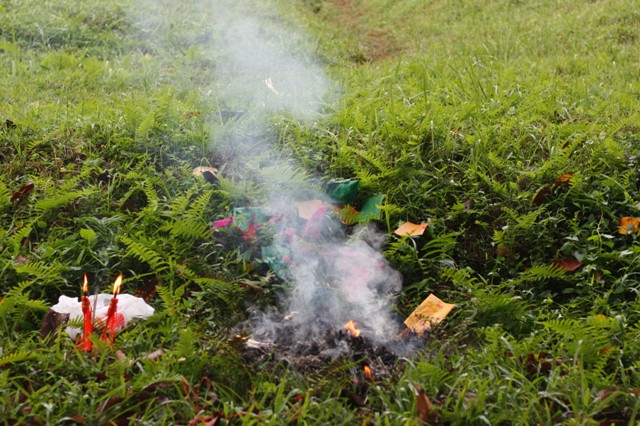
Simple offerings of tea and candy by a woman who comes here yearly to pray for her infant aunt who died during the war. The infant’s burial was not registered so the exact location of plot is unknown.(photo Sugen Ramiah)

The Ng Family has to charter a bus to transport the entire family for Qing Ming (photo Sugen Ramiah)

The Ng Family has to charter a bus to transport the entire family for Qing Ming (photo Sugen Ramiah)

A young boy from the Pek Family, who looks forward to Qingming annually, as he gets to visit the tomb of his Lau Yeh (Great grandfather) and meet his cousins. Photo taken at the tomb of his Great Grand Father at Hill 3 (photo Sugen Ramiah)

Descendents observing Qing Ming in a less taxing environment at the Cantonese Ancestral Hall of the Singapore Hok San Clan Association (photo Sugen Ramiah)
It has been a rewarding experience, to learn from family members on how they up hold traditions that has been handed down to them. All they hope is that these traditions will be carried on by the generations to come and that their ancestors will not be forgotten. I will close with a quote that is close to my heart.
“To acknowledge our ancestors means we are aware that we did not make ourselves that the line stretches all the way back, perhaps to God; or to Gods. We remember them because it is an easy thing to forget: that we are not the first to suffer, rebel, fight, love and die. The grace with which we embrace life, in spite of the pain, the sorrow, is always a measure of what has gone before. ” – Alice Walker
***
Sugen Ramiah is a teacher by training and his interest includes observing and documenting Chinese festivals and rituals conducted by temples.
Read his blog posts on Salvation for Lost Souls here and here
Read about the tombkeepers’ Qing Ming here
The Lim Hock Seng Family
An update:
On the morning of Sunday, June 22 ’14, Raymond Goh was on his usual weekend exploration of Bukit Brown when he came across the tomb of Ngo Kim Neo who died young at 22 years old in 1927.
On her tomb was inscribed, she was the wife of Lim Hock Seng (see the original story below) and she left behind 4 children, Sons: Lim Cheng Chuan and Lim Cheng Ean; Daughters: Lim Khoon Neo (Lucy) and Lim Geok Kiat.
What was intriguing was the name of Lim Cheng Ean which was included in the inscription as her son, as he was born in 1934, 7 years after the death of Madam Ngo Kim Neo.
We emailed the daughter of Lim Cheng Ean to inform her of the find and if she could throw some light on the matter.
This was her reply:
“I have managed to gather some brief knowledge about Ngo Kim Neo from my mother. Apparently Lim Hock Seng married 2 sisters. The first died very young without children and her grieving parents offered their second daughter, who must be Ngo Kim Neo, to him. She had 2 daughters and then sadly died giving birth to my father’s older brother, Lim Cheng Chuan, who was known in the family as the ‘Tiger Baby’ because he ‘ate his mother while being born’ (1927 was indeed the year of the tiger) . I’m not sure if this is a Chinese superstition, or just a Lim family ‘fable’. My father will be so moved to see the photo that I am posting to him today. I doubt he has ever seen the grave, or his own name credited as her son on the tombstone. His sister, Lucy (Lim Khoon Neo), was very close to him ” Gillian Mendy nee Lim, 23 June’2014
Gillian further explained that, her father’s (Lim Cheng Ean) mother was Lim Hock Seng’s third wife, Khoo Ah Tho, brought from Penang to marry him and look after the 3 young children left behind by Ngo Kim Neo.
From Gillian’s information, we gleaned that after Lim Cheng Ean was born, the tombstone of Madam Ngo was replaced to include his name to acknowledge Madam Ngo as his mother. We are not sure what customary practice led to this, or maybe it was a husband’s last loving tribute to the wife who bore him 3 children before she passed away at childbirth at the tender age of 22.
In sharing with us the close relationship her father had with his half sister, Lucy Lim Khoon Neo, Gillian attached an article on her aunt’s wedding and another line of family connection was revealed. Lucy Lim married Cheong Thiam Siew, Chairman of Frank Knight, who was the son of Cheong Hock Seng, and grandson of Cheong Koon Seng Her husband came from an illustrious and blue-chip line of property auctioneers.
And finally Gillian shared that her father who was in a fragile state of health when she first wrote to us in in January of this year, has improved and just celebrated his 80th birthday. The family put together a scrap book of his Lim ancestors, and the photos we had sent earlier of his father’s and his grandparent’s graves at Bukit Brown was the centerpiece of the book.
*****
All Things Bukit Brown received an email this morning (14 January) addressed to Raymond Goh. It was from Gillian Mendy (Lim) from London, asking if her grandfather’s Lim Hock Seng’s grave was affected by the highway. Her email read:
“Your Bukit Brown website is incredibly informative and interesting. We have only just discovered about the planned road works through the cemetery.
My grandfather is buried at Bukit Brown and we are trying to find out if his grave is affected by the road project. The family now live in England. If it is affected then we would come to Singapore to claim the remains.
On 2nd January, 2014, June Tan witnessed and photo documented the exhumation of her grandfather, Ong Kim Soon. She also shared with us the testimonial of how a promise was fulfilled to carry on the lineage of another family. It speaks to men and women of honour and ties of kinship which live on till today.

The exhumation of Ong Kim Soon begins, after the family conducted their pre- exhumation rituals (photo June Tan)
***
By June Tan
My grandfather was an ordinary man. He worked hard to make ends meet and was an honest man of principles. When he passed away at the age of 47 , he left behind his wife & 6 children aged between 6-22 years old then.
The story I want to share of my grandfather has to start from my great great grandparents.
My great great grandfather Ng died at a very young age. He was in his 20s then. He left behind his wife but no descendants. The women of that era usually did not remarry if their husband passed on. It was deemed to be their duties to take care of their in- laws .
However, my great great grandmother was a young lady in the prime of her life at that time. Her mother- in- law decided that she should not stay as a widow and allowed her to remarry. She, however, set a condition for the man (suramed Ong) who was to marry her- that the first son born by them had to take the surname “Ng” (黄). As a gratitude to the old lady, they readily agreed.
Soon after, my great grandfather was born and he took the Ng surname. However, great great grandfather Ong soon fell very ill and with his wife they were unable to produce a 2nd child. Their son, my great grandfather had no option but to reinstate his surname to Ong in order to perpetuate the Ong family line.
The older generation is a generation of principles. It was resolved that the next male child born in the family will carry the surname of Ng to honour the promise of my great great grandparents.
Years later, my grandfather was born and he adopted the “Ng” (黄) surname. In fact, of the 3 sons born in that generation, my grandfather and his 2nd brother took on the Ng surname as a gratitude to the Ng family.
At age 47, my grandfather passed away. All that he left behind was a meagre sum of S$24. The family was faced with the task of paying for a decent burial place.
Seh Ong Sua (which adjoins Bukit Brown) was the only cemetery with free burial grounds available for the Ong descendents . My grandfather’s brothers, my grand uncles, approached the person in charge of the Ong Clan then. However, only descendants of the Ong clan could be buried there. After hearing the origins of my grandfather’s surname, the Ong clan agreed to accord him a burial ground in Seh Ong on condition that that he had to use his Ong surname on the headstone of his grave.
Hence, the surname on his tomb is Ong (王) whereas his children will continue to take the Ng surname.
For these reasons, my great grandmother had “set” a rule for my mum’s generation that they are allowed to marry Ngs’ but not Ongs’ as that is the origin of their bloodline.
***
A few photos from June Tan’s album of her grandfather’s exhumation. The coffin was fully intact and the set of bones, nearly complete. With her permission, the complete album which she has captioned as a photo essay, is available here

The remains after the coffin (which was fully intact) was opened with an electric saw (photo June Tan)

The bones are washed with white wine as required by traditional exhumation practices. (photo June Tan)
***
Ong Kim Soon has moved to Yishun Columbarium. Rest in Peace.
Editor’s note: We would like to thank June Tan for sharing her photos of her grandfather’s exhumation and her family story with us. If you are a descendant who has ancestors staked for exhumation, please share your story with us.
Email us: a.t.bukitbrown@gmail.com
You can read about another first hand account by a grandson, who witnessed his grandfather’s and aunt’s exhumations, here
by Sugen Ramiah
While exploring Hill 4, I stumbled upon a tomb of a young man, by the name of Ee Tean Choon.(E Tean Choon on tombstone)
It was very unique because the tomb was of a modern design in marble. And so I started a little research on his family in early November 2013. It was on the 31st of December 2013, while strolling with brownies Peter and Ee Hoon, that I was told that there was another art deco tomb, similar to that of Ee Tean Choon that also belonged to the Ee family, his grandparents. Here’s what I have traced of the Ee Tean Choon family tree.
Grandparents: Ee Swee Hin and Khoo Swee Yee
Ee Swee Hin passed away on the 8th September 1942 and his wife Khoo Swee Yee, on the 19th February 1955. They are buried together in Hill 5 Division B with LTA tag #1122 and will be exhumed in March.
Father: Ee Yean Keat
Ee Yean Keat was the eldest son of Ee Swee Hin and Khoo Swee Yee. He had two other siblings, Ee Yean Bee and another adopted brother – Tan Eng Yam. Born in Malacca in the year 1884, he was educated in a high school there and came to Singapore to look for a better future. He married Seow Joo Neo and had seven children. He first started work with Netherlands Trading Society in 1904. After 6 years, in 1910, he worked as a cashier with the KPM shipping company. He wanted an early retirement after 25 years with the shipping company. However, he later joined the Straits Times Press (Malaya) Ltd and officially retired in 1959 at the age of 75. He was also known as the “Grand Old Man’ of the accounts section of Straits Times Press (Malaya). He passed away on the 24th of September 1968 at the age of 84. The Obituary section in the archives indicates that he left behind 2 wives. Seow Joo Neo the mother of Ee Tean Choon, passed away on the 4th of January 1985 at the age of 102. She left behind 19 grandchildren and 16 great grandchildren. No information has been uncovered about Ee Yean Keat’s other wife.
Ee Tean Choon (E Tean Choon on tombstone)
Ee Tean Choon born in the year 1910 and was the first born of Ee Yean Keat and Seow Joo Neo of No.350 East Coast Road. He was the eldest of seven children. He married Ruby Chia Boey Neo , the fifth daughter of Mr & Mrs Chia Keng Chin of No.8 Saint Thomas Walk, on the 3rd of October 1936. Chia Boey Neo the grand-daughter of Mr Chia Hood Theam, was born in July 1914 and was 22 years old when she married Ee. They didn’t have their own children but adopted two babies -Willie Ee Kean Leong and Margaret Ee.
Sadly, Ee Tean Choon died of typhoid, on the 3rd of April 1938, at just 28 years old. He left behind a young widow and two infants, barely two years after his marriage. The two infants were then adopted by his brother, Ee Tean Cheng and the young widow returned to her parents’ house.
Inscribed on the tomb is an epitaph :
‘In the prime of his life death claimed him, In the pride of his manhood days, none knew him but to love him, None mention his name but with praise.’
I believe that the epitaph was taken from ‘The life of Rev. William James Hall, M. D.: Medical Missionary on the slums of New York, Pioneer Missionary to Pyong Yang, Korea’ 1897. It is about how Rev Hall ministered to the sick and wounded of Korea and his martyrdom. Coincidentally, both William (Willie for short) Willie and Margaret, were the names of Dr. Hall’s great grandparents.
Ee Tean Choon is buried in Hill 4 Division C with LTA tag #2612. He has been claimed by the family of his wife, the late Mdm Chia Boey Neo.
Brother : Ee Tean Cheng
Ee Tean Cheng was actively involved in many athletic associations such as the Useful Lads Badminton Party, Horlicks Badminton Party and was elected as vice president of the S.A.S.U (Singapore Armature Sports Union) in 1940. The tournaments, training and meetings were often held in the badminton court of the Ee’s residence at East Coast Road. He worked for Ford Motors and married to Ong Lian Neo Nellie on the 15th December 1940. Unfortunately, she passed away on the 26th October 1941 while in labour, both mother and child didn’t survive. She was buried in Bukit Brown and Raymond Goh has a blog post on her life here
Ee Tean Cheng had a second marriage to Lily Oon Siok Neo. They had a son, Winston Ee Kean Leng and also adopted the late Ee Tean Choon’s children – Willie and Margaret. He had five grandchildren. He passed away on 3rd April 1999, coincidentally the anniversary of his brother, Ee Tean Choon ( 3rd April 1938)
Brother: Ee Tean Chye
Colonel Ee Tean Chye was the first Commander of the Singapore Air Defence Command and in 1972, the first Chief of Air Force of the Republic of Singapore Air Force. He has three children, Patricia Ee, Laura Ee and Christopher Ee.
Son: Willie Ee Kean Leong
Willie Ee Kean Leong was the director of Sankyo Seiki Singapore Pte Ltd. He married Lim Eng Hong, eldest daughter of Mr Lim Kim San, former cabinet minister and first chairman of HDB. They had two children, Ee Kuo Ren and Ee Yuen Ling.
Daughter: Margaret Ee
Margaret Ee married Mr Richard Png and had two children, Dr Kenneth Png and Keith Png.
Postscript : Unfortunately both grandparents and grandson will be moving house to make way for the new highway. However both grandparents and grandson will be interned in the same block in Choa Chu Kang Columbarium. This is just another story of another ordinary family that has contributed to this country. May they rest in Peace.

Offerings for Ee Tean Choon on the day of the Winter Solstice 21 December 2013, prepared by brownies Choo Ai Loon and Sugen Ramiah (photo Sugen Ramiah)
Sugen Ramiah is a teacher by training and his interest includes observing and documenting Chinese festivals and rituals conducted by temples. This is his first foray into researching family trees.
Read his blog posts on Salvation for Lost Souls here and here
References for Ee Family
The life of Rev. William James Hall, M. D. : medical missionary to the slums of New York, pioneer missionary to Pyong Yang, 1897. (E-book) Emmanuel College Library, Victoria University
Announcement. (1936, June 23). The Straits Times
Tean Cheng-Ong. (1940, December 16). The Singapore Free Press and the Mercantile Advertiser
Deaths. (1941, October 26). The Straits Times
Cashier, 75, Retires for Second Time. (1959, December 31). The Singapore Free Press
Deaths. (1968, September 25). The Straits Times
Deaths. (1985, January 5). The Straits Times
Condolences. (1994, September 4). The Straits Times
Deaths. (1999, April 4). The Straits Times
Deaths. (2000, June 20). The Straits Times
The Air Force, Singapore : Republic of Singapore Air Force, 1988
Controlled Growth Restriction Policies For Certain Closed Food-Chain Systems by Patricia G. M. Ee 1992. Simon Fraser University, April 1992.
Pre- exhumation rituals for the nearly 4,000 pioneers who will have to be exhumed to make way for the highway, took place on the morning of Thursday, 28th November. A short and simple ceremony, it was organised by the Land Transport Authority and Swee Hong construction company for descendants. More than 500 descendants together with well wishers and brownies were in attendance.
The rituals were conducted by 7 members of the Inter Religious Organisation.
Prayers were offered for the peaceful move of the soon to be exhumed pioneers to their new homes and for the safety of the people who will be working on the site.
The descendants who arrived were confronted by a new almost “fortress-like” Bukit Brown where barriers had been put up in preparation for exhumations, scheduled to begin in December 2013
The area for the ritual prayers was under a marquee enclosed by a metal barrier and restricted to descendants. Registration was required.
The area within was quickly filled to capacity
It quickly became standing room only
The scheduled time to begin the prayers was 10am. It was delayed because of the unexpected crowds and started about 15 minutes later.
Religious leaders from left to right represented: Jainism , Buddhism , Taoism , Hinduism , Christianity, Sikhism and Baha’i faith (photo below)
The religious leaders took their turns to pray starting with Jain leader in pink, followed by Buddhist leader. (photo below)
The Taoist leader (in black robes) was followed by the Hindu religious leader
The prayers took about 10 minutes and the ceremony was over. A few descendants took the opportunity to also pay their last respects personally to their ancestors and came bearing offerings.
Victor Lim, a brownie offered his own prayers of remembrance and respect to the earth deity at the Lorong Halwa gates. Bukit Brown to him is a place to remember his ancestors and affectionately as he is always wont to say “my playground”
Victor Lim : “I don’t know when we can meet again. Since the past 1 1/2 years, we have been meeting with those lonely souls every week. This morning we are departing from this endless, from a party that needs to be dispersed. Alas, we would still need to leave and this brings me good memory. I wish you all the best, bless you peace when you leave, and may this good luck come forth to your new home. We will think of you now and then, and we will be together , not forgetting the milestones of our social memories and roots.”
And finally, all the way from London, Sugen Ramiah remembers Bukit Brown in his prayers at the Westminster Cathedral. His message : While Rev Fr Paul Staes said a prayer for the dead in Bukit Brown, I too lit up a candle and said a prayer for the dead in the Chapel of Holy Souls.
Eternal rest
grant unto them O Lord,
may perpetual light
shine upon them;
May they rest in peace. Amen
Amen, indeed amen. A ceremony that seem all to short, commemorates a farewell to those for whom Bukit Brown has been home for decades. We wish you all a safe and peaceful passage to your new homes.
Read Walter Lim’s blog on the rituals in Chinese here
A postscript. Thursday, 28 November 2013, was also the day the Roundabout became a Road.
Follow the path of destruction here







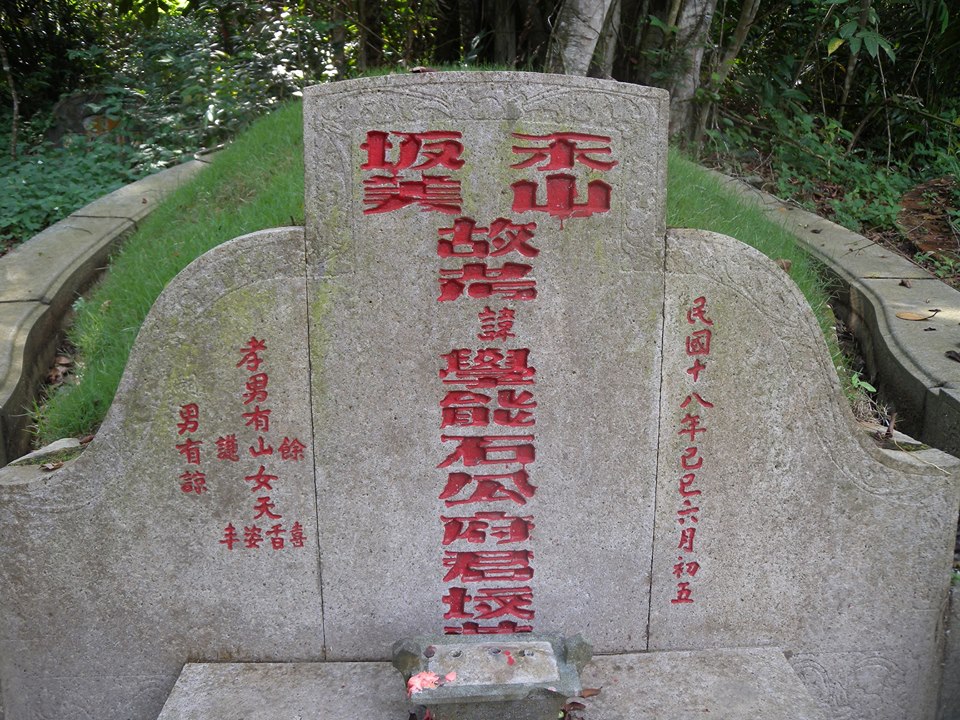









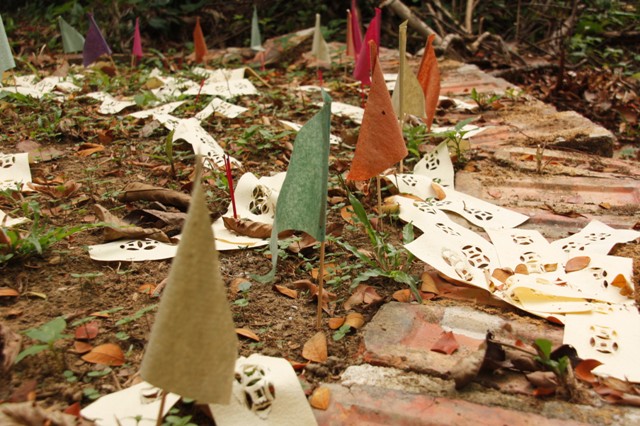




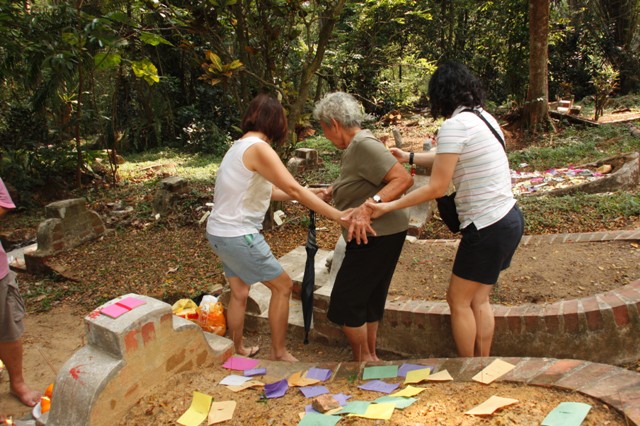

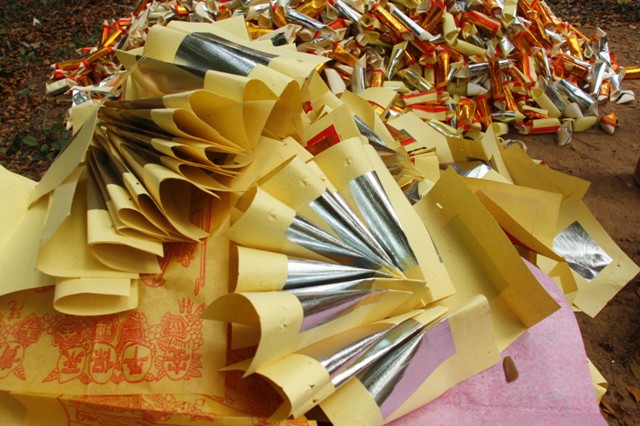




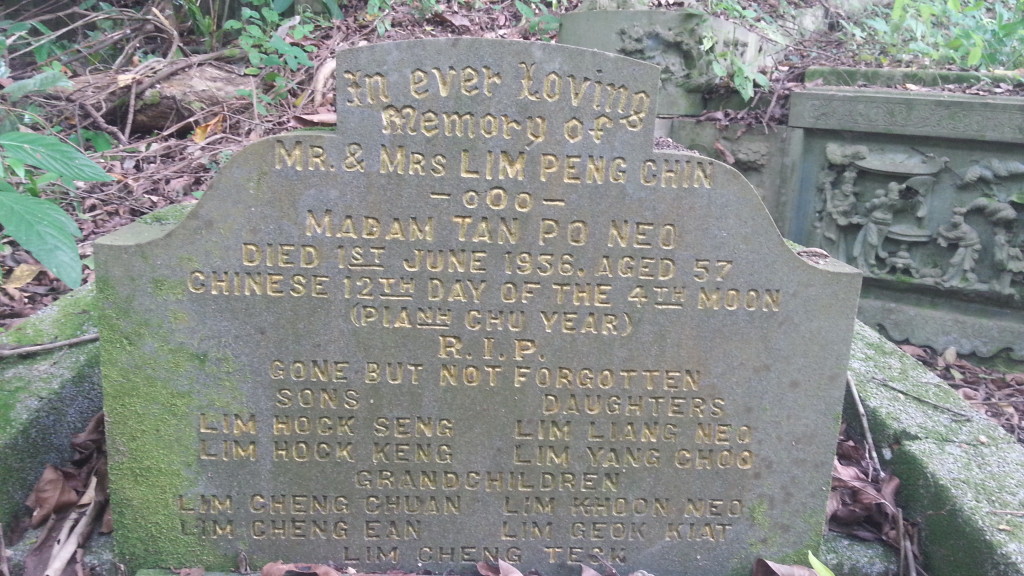






















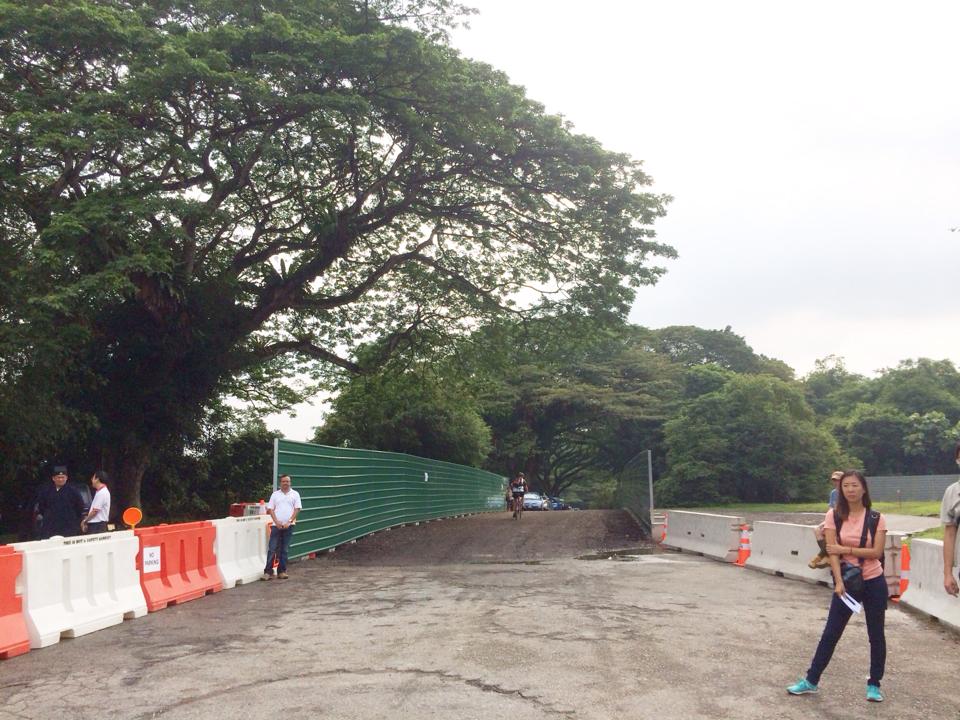
Recent Comments